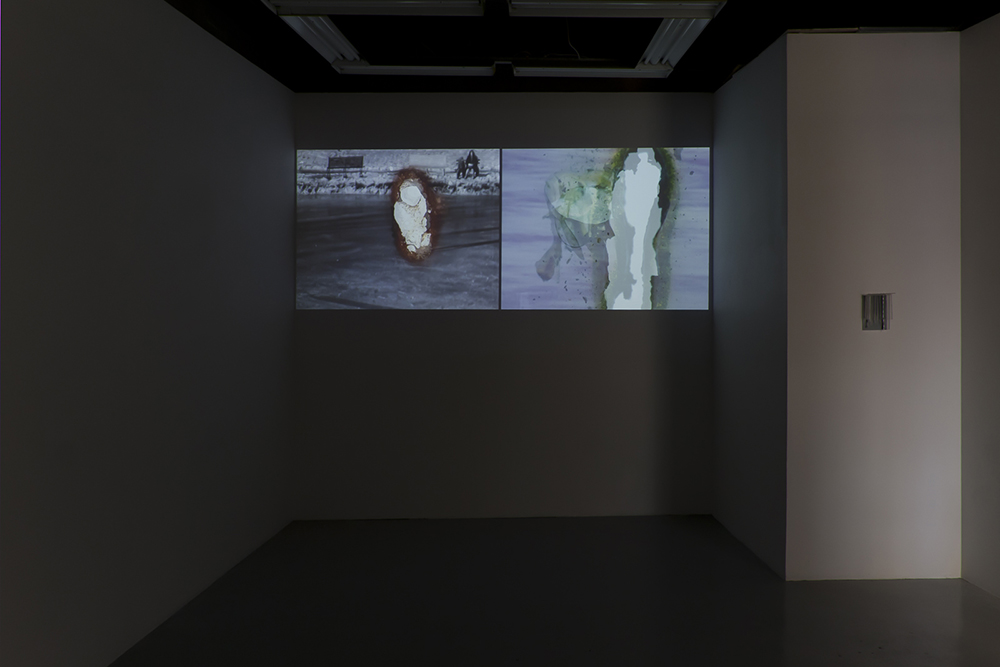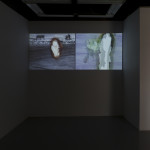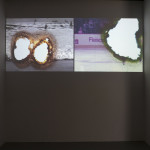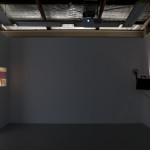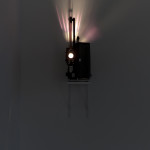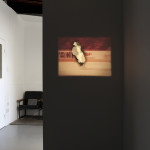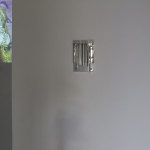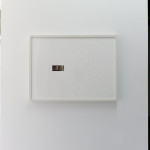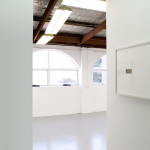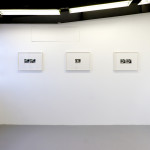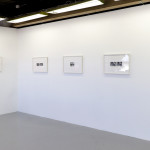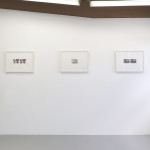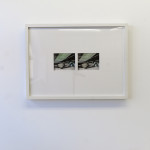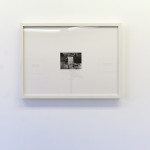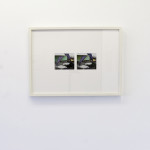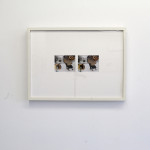Room 1
TIME ON ICE
For the last two years I’ve been focusing the sun through a magnifying glass onto the figures of ice skaters in the consecutive frames of two 16mm films. One is from the late 1930’s and the other from the 1970’s. Acetate film resembles ice.
This iconoclastic tally of burnt cells, (at 24 frames per second), is the result of an obsessive attempt to recapture that rare moment when a figure in motion on the cinema screen would abruptly freeze. For a split second, the blink of an eye, a flood of obtuse meanings was ignited that bore no relation to the prior narrative trajectory of the movie. Then the image, caught in the film gate of the broken projector, melted under the intense heat of the lamp. The audience, suddenly released from their screen-trance, would awake en masse in the enormous room.
The liberating potential of this event, this disruption to the visual flow, (its afterimage burnt into my memory), is without ground in the era of the touch screen: i.e. is on ice.
Here I offer work to give a taste of this burn.
Room 2
CROSS-EYED COLLAGES
These collages use reproductions of 1930’s photos with pasted images cut from 1970’s magazines. The doubled images are stereographic collages, achieved by putting the same elements in both works slightly out of register. In order to see the 3-D effect without a device, you must stand relatively close, cross your eyes and try to bring one image into focus. While initially difficult, perhaps even painful, the time spent will result in a richer vision, as both eyes work together. (The skater achieves better balance by pulling the laces of their boots as tight as possible. This is how to ‘walk on knives’).
Narrative 1: Nick Strike’s Time on Ice
Mise en scène
Throughout his installations and his imagery, Nick Strike returns again and again to the same settings: a forest, or an ice lake, or a cell. A scene waiting for a narrative, for history to meet it. The forest obscures and reveals. The ice screens off the depths. The cell is inescapable, a shape‐shifter: it is the prison, the cinema, the gallery, the studio, the film strip, the frame, the rink and the mind.
Characters
Strike’s last solo show at 55 Sydenham Rd, October, was punctuated by images of divers plunging into water. In Time on Ice, the divers have been replaced with ice skaters who endlessly circle the impenetrable surface of their frozen ground.
Two film loops screen side by side in a silent, stereographic projection on the main gallery wall. One half of the projection field is black and white footage from the 1930s. The other is colour film from the 1970s. At the centre of each frame is an ice‐skater in motion. The figures spin, twist and lunge across the ice, but in the place of identifying features is the transfixing flicker of seared acetate. Each individual film cell has been precisely blistered by the sun, focused and directed through Strike’s burning lens.
On a return wall opposite the dual image, another section of the 1970s film is projected through a vintage 16mm projector. Extending from the burn field is a single leg footed by a bladed skate. The limb pivots with forceful precision on the ice, like a drill intended to penetrate the surface, or a stick briskly rotated for the purpose of starting a friction fire. The noise of the film projector takes the place of a soundtrack; the whir of metal and acetate approximating the sound of a metal blade grazing the ice.
The fourth projection, a short loop on a monitor, is visible when leaving the gallery by the stairs. In a close‐up shot, hands pull laces tight through the eyelets of an ice skate. Then, an abrupt edit: a man’s face fills the screen. His eyes are missing. His eye sockets scorched by twin burns.
Nick Strike is an auteur. Like Hitchcock’s interchangeable blondes, Strike’s characters are ciphers. They don’t require internal lives: they are symbols, and stand‐ins and doubles, for the real action taking place somewhere behind the screen and below the surface.
Narrative rupture
Strike’s work is often concerned with the mechanisms of vision: the anatomical, technological and perceptual means by which we see and make sense of what we see. His work is equally preoccupied with impediments to vision: to physical blockages, mechanical failures and misreadings.
In a statement that accompanies the exhibition, Strike writes that his labour intensive burning of film is intended to recall the rare occasions a celluloid film would ignite, mid‐screening, in a cinema projector. As the film perished under the heat of the lamp, the image on screen froze; and the audience were shaken collectively awake from their viewing trance. The rupture in the narrative awakened the audience to their own lives, just as the moving stream of images had suspended their awareness.
When Strike’s own film reel broke in the projector during the exhibition, he sliced out the damaged section of film and lodged the strip, in storyboard rows, between two pieces of perspex. It was a restating of the workings of cinematic illusion, the multiple still‐lifes that create the appearance of movement and of narrative.
With his practice of applying a burn to every cell of a film, Strike ruptures the existing narrative while overlaying one of his own making. He reinforces the illusion of cinema while taking it apart; waking his audience while lulling them into a trance. He makes, in effect, a stereograph of sleep and wakefulness: a cognitive prompt to consider narratives and images from both states.
Narrative props/motifs
There is more material to view: a sheet of perspex covers the stair landing; the gallery window is cracked; there is a film still of a woman, without a face, touching the screen her son is imprisoned behind; a hole in the gallery floor is reflected back on itself; a photograph of a forest is obscured by perspex strips. Strike sets in play the narrative of the space; his installation a perpetual signifying machine, amassing links and associations between matter and concepts.
—ice—perspex—glass—skates—blades knives—razors—eyelets—eyes—stereogram—magnifying glass—sun—projector—focal point—lens burn—friction-fire—frostbite—ice hole—cracked screen—
Strike draws from a roll call of imagery related to the eye, to seeing, and to technologies of vision: Bunuel’s Un Chien Andalou, Bataille’s Story of the Eye, Walter Benjamin’s concepts of the optical unconscious and the dialectical image, Hieronymous Bosch’s painting Temptation of St Anthony (with its camera obscura and ice‐skating bird) and Roland Barthes’s essays ‘The Metaphor of the Eye’ and ‘The Third Meaning’. Strike has often mentioned these references when talking about his work; it’s only as I type them that I notice that all the surnames start with B, and that B looks like a pair of glasses, or a stereoscope, on its side. It’s the kind of coincidence that Nick Strike tracks and incites in his work. The analogous narratives of the unconscious: revelatory, erroneous, punning and erotic; the absurd, the wishful, and the horrific. All as indispensable as the next.
Point of view
Like a cinema foyer walled with film stills, the front gallery at 55, is hung with Strike’s collages. Six are actual stereograms. Two near‐identical images mounted in the same frame are an invitation for the viewer to cross their eyes, adjust their focus and by the diligent, and somewhat painful, application of each eye, create one single, composite three‐dimensional image.
As with the ice‐skating films, the collages are made up of photographic imagery from the 1930s and the 1970s. Strike is nodding at the proposition that the precarious economic and cultural terrain of both decades is matched by the fragility of our own. By overlaying the image banks of the two decades in a stereographic process and method, Strike speculates that something of our present time will be revealed.
Scenarios float in and out of view. Place and time are indeterminate. There is war and there are dreamscapes. There are mass gatherings, uniforms, and wayward bodies: outsized, morphing, fragmenting. There are skewed monuments and unstable landscapes. There is the forest, the ice lake, the cell. And a screw, a drill, an orifice, a carcass, an eye, twin pools of water, a pair skating couple, an amputated leg. Obstacles in search of a narrative. Evidence in search of a crime.
Lynne Barwick, March 2016
Time On Ice
Nick Strike
26/2-13/3/16
